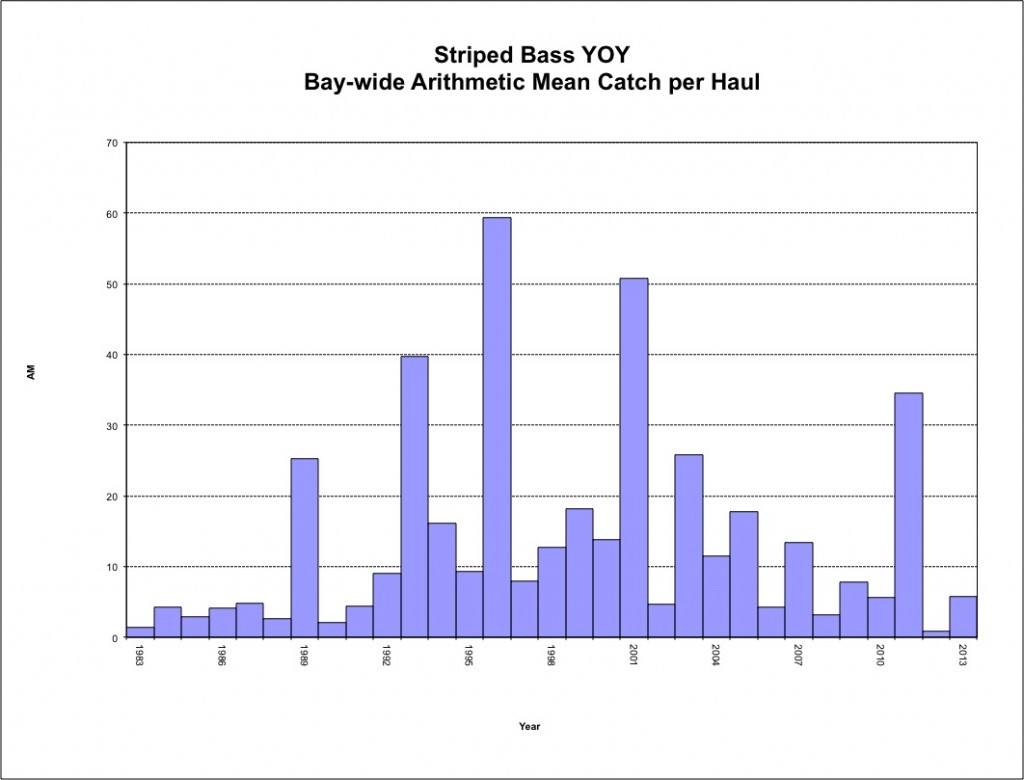Striped Bass Stock Status
At its annual meeting on October 29, 2013, the Atlantic States Marine Fisheries Commission (ASMFC) adopted a new stock assessment. In a nutshell, the assessment shows that while the spawning stock biomass is not yet critically low (as of the end of 2012), we have reached the overfished threshold and are well below the target level set in 1993 when the stock was first thought to be recovered from the crash of the 1970’s. The overfished threshold is a point at which the spawning stock biomass would slip below the level it was at when the successful 1993 year class was spawned, and is calculated to provide what is thought to be the minimum acceptable spawning stock – one with some margin of error that could produce the much larger year classes needed to support a robust recreational fishery.
The current level of fishing mortality, while below the threshold in 2012, is now forecast to be greater than the prescribed target, which means that too many fish are being killed by fishermen to maintain the target spawning stock biomass.
Striped bass spawning success varies from year to year. But the recent Young of the Year (YOY) spawning numbers are very disturbing. The 2013 YOY count of striped bass spawned in Maryland’s portion of the Chesapeake Bay was below the average of the last 20 years (see graphic below). A year earlier, in 2012, the YOY count was the worst ever. The Hudson River, which is the second largest producer of baby stripers on the Atlantic Coast, has now had three years of poor spawning success. Striped bass are the major predators in their niche, and nature designed them to grow large and to spawn over a long lifetime. Some biologists are greatly concerned that the management concept of focusing harvest on the larger, more mature fish in the population is destabilizing and could lead to long-term spawning disaster.
Further evidence of the declining fishery is evident in greatly decreased recreational catches and a lower CPUE coast-wide. CPUE stands for catch-per-unit effort which simply means how many fish are caught during the time spent trying to catch them. The catch declines have been reported throughout the migratory range of the striped bass.
Paul Diodati, the Massachusetts Director of Fisheries, offered a plan to cut the recreational catch in the coastal fishery from two fish at 28 inches to one fish, and to make a cut of corresponding magnitude — about 38 percent — in the commercial quotas. Diodati said he had been on the water and seen firsthand what has happened to the fishery. He also said the latest stock assessment shows that the ASMFC should have taken steps to reduce fishing mortality several years ago.
Unfortunately, most other members of the ASMFC were not prepared to make immediate cuts. It is impossible for us to understand why, especially since opponents of Diodati’s measure include representatives of several states where the striped bass is already a game fish. Instead, the ASMFC charged the technical committee to come up with a list of five possible measures beginning in 2015 that are designed to bring the population back in line with the target spawning stock biomass. We think these reductions will be too little too late and that far greater cutbacks will be required down the road.
Stripers Forever feels that harvest reductions are needed now to lower striper mortality and raise the level of the striped bass population coast-wide. Stripers Forever was started 10 years ago because many of us could see the quality of the fishery begin to slip away almost as soon as catch levels were increased to the current levels. The YOY graph reveals that the year classes since 2000 have been on average much smaller than those in the 1990’s. Nothing can change that — the fish are simply not in the pipeline to support the current levels of fishing mortality. No one really understands how much fishing pressure striped bass can take and still reproduce successfully, but it is obvious that the fishing pressure needs to be substantially lower than it is now.
Stripers Forever has bills in the Massachusetts legislature that would remove the part-time or “recremercial” fishermen from the fishery, reduce the commercial quota correspondingly, and eventually sunset the commercial fishery completely in 2025. We will also carefully monitor the ASMFC’s deliberations on striped bass and through our membership try to influence the decision making process to adequately reduce the harvest and help turn around the declining population.







